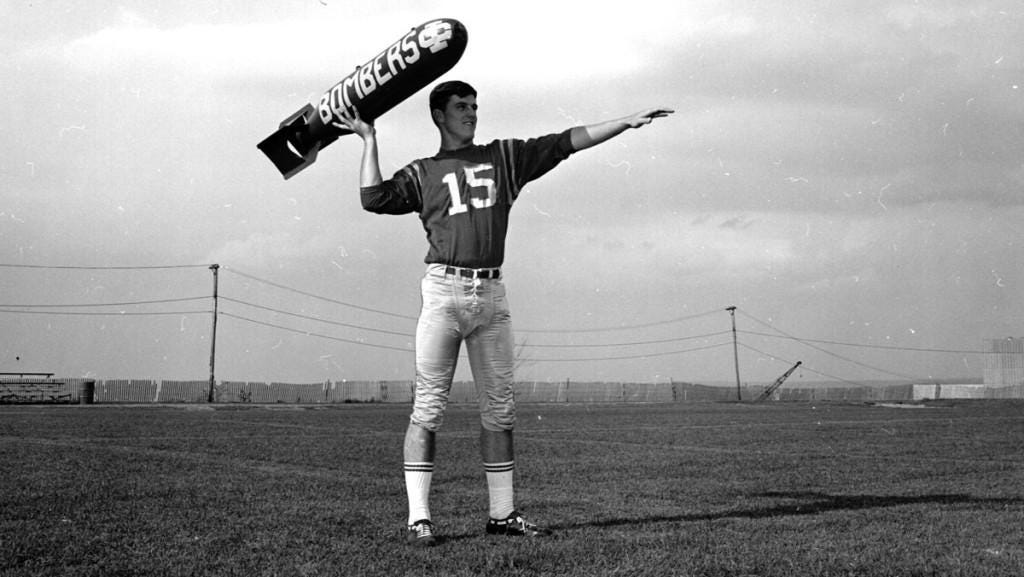(a)bomb-ination?
The Ithaca College nickname is completely bonkers and we love it.
Once again, the Ithaca Bombers put on a great show at Division III nationals. Led by standout freestyler James Collishaw, the Bombers scored points in the 100 Free and nearly finaled in 200 Medley Relay. Congratulations to Alec Kustner, Matt Mitros, and Michael Paulos who along with Mr. Collishaw, made Ithaca competitive in four different relays.
On the Women's side, Ithaca dominated diving. Kailee Payne won both the 1 meter and 3 meter events and her teammate Abby Marraccino also finaled in both. Ithaca Junior Angela Burke just missed finals in the 3 meter event. It was a very impressive showing. So impressive in fact that Ms. Payne won CSCAA Diver of the Year honors, and her coach, Chris Griffin, earned his third CSCAA Diving Coach of the Year award.
Which was nice for us spectators because we got to hear the announcer say 'The Bombers' several times, and enjoy this marvelously odd team nickname.
Implausibly, the nickname of the sports teams at Ithaca College is 'The Bombers.'
There's something about 'Bombers' that is, well, inescapably linked to bombing. And, not surprisingly, this plain-language link has generated some discomfort in the recent past. Less predictably, attempts to change the name, or soften its connotation by attaching it to one of the logos below, have been wholly unsuccessful:
In the wake of these efforts, and the clear statement of many current athletes and alumni that they do not want the name changed, a fragile truce has emerged. A cease-fire, if you will. In which 'The Bombers' name remains, and no official logo exists.
The logic for having no logo is clear. A logo will either undermine the clear meaning of 'The Bombers' which is intended be both intimidating and absurd. Or, conversely, a logo would solidify the nickname's connection to military and wartime imagery in a way that might - ultimately - prove to be the undoing of the nickname.
What did we mean when we said 'absurd'? Well, they do have an on-again-off-again mascot, "Bomberman." (Swear to god we are not making this up.)
Bomberman looks like a cross between a World War I military aviator and an early-20th Century radical anarchist looking to plant an inconspicuous homemade explosive device at a busy intersection. (Yes, we are aware that Mr. Vanzetti did not try to bomb anyone and was probably not guilty of the charges against him.)
Here is Bomberman dressed as Santa.
Anyway, they love The Bombers nickname in Ithaca, and good for them.
There are some attempts to be squirrelly (maybe that is the otherwise incomprehensible inspiration for the failed flying squirrel logo above) about whether "The Bombers" really means, you know, bombers. Generally, these arguments point to the usage of the nickname by some sportswriters in the 1930s, possibly in reference to long-range shots in basketball, passing by the football team, or maybe a reference to the simple uniforms worn by the baseball team reminiscent of the most famous baseball team of that or any other era, the New York Yankees, or Bronx Bombers.
So, the logic goes, the Ithaca Bombers is not a reference to bombers and bombing as such, but a carryover nickname from the Bronx Bombers or various analogical sporting equivalents.
Which is a pointless semantic exercise because it all still comes back to bombs. The nickname dates back to a time when violent imagery in culture and sports was far more accepted than now. Legend has it that the first Bombers from uptown NYC were the Harlem Black Bombers, so named by their owner, Bill Robinson, who was also a combat veteran of a unit called the Harlem Hellfighters. In naming his team The Bombers he was certainly not trying to distance his team from combat imagery, but rather to feature such imagery in the team's identity.
By the mid-1930s, Joe Louis was ascending as America's top boxer (and this was at a time that boxing was popular in America in a way that is almost unimaginable now) and his most durable nickname was 'The Brown Bomber.' This was both a reference to his skin color (...it was a different time) and the fact that he was famous for hitting other men in the face really really hard. Thus the reference to bombs, with their explosive and destructive power.
In short order, the Yankees were dubbed the Bronx Bombers, in large part because of their ability to hit home runs. Home runs have long been called 'bombs' in baseball, again because of their connection to power, the way in which they can explosively reshape games, and probably not least because they do also fall from the sky. ‘Bombs,’ as a term, is embraced because of its close proximity to, not distance from, combat imagery. Amusingly, references to the Yankees as the Bronx Bombers marked a ratcheting down of the violent imagery around the team. Barely ten years earlier the 1927 team was famously and simply known as Murderers' Row.1
The Bombers nickname is inescapably violent and warlike. It is also old, beloved, distinctive, and kind-of nuts, making it a classic Division III nickname. And, as such, something we are in favor of preserving.
The Two Owls Problems
Do we see the arguments against calling your sports team The Bombers? Of course. They are obvious. But no one is talking about giving this name to a new team. The question is whether to take the name away from a team with a long history attached to that name.
Would it be different if the team name referred to the color of someone's skin or some derogatory racial stereotype? Of course.
But the Bombers is a nickname that is not offensive to one group or another. It is just a weird holdover from a different time. And we worry about the impulse to follow the first cringe into doing something that destroys a tradition and that also robs a storied program of a key part of its identity.
Take Kenyon as an example of how this can all go awry.
The First Owls Problem
The first Owls problem is simply: What if it doesn't work?
The single most successful program in the history of the NCAA, any division, is Kenyon swim/dive. No team has won as many national titles in one sport as Kenyon has won in swim/dive. In fact, in terms of total national titles - all sports combined - in the NCAA, Kenyon is behind only Stanford, UCLA, and USC. And all of Kenyon's national titles (except for three women's tennis titles in the mid-90's - Go Ladies!) are swim/dive titles. No school's entire athletic history is more heavily defined by a single sport than Kenyon and swim/dive. Also, in no other sport in any other institution, is the glory so evenly divided between the accomplishments of athletes competing in Men's and Women's events.
So it is not a radical statement to say that in order for 'The Owls' to really take as a new nickname, swim/dive - both the Men's and Women's teams - needed to accept it.
Here are two celebrations from Kenyon after they won the Men's and Women's titles at this year's NCAC championships. The first involves just the ladies and is charming and brief. The second longer cheer involves the entire team, men and women, swimmers and divers.
So, on The Owls thing, you tell us how you think it is going. Our takeaway from the primary evidence is that these are the Lords and Ladies. And nobody ever says the word 'owls.'
All of this, of course, ends with a loud 'KENYON!' The athletes don't see themselves as rebels fighting against the tradition of the school's athletic programs. They see themselves as the protectors of that tradition, those who preserve and perpetuate it. The Lords cheer makes several 'inside' references including to a legend about a catastrophic hazing incident in which a drunken Kenyon student was decapitated by a train in 1905. It is the athletes who embrace Kenyon's history, warts and all.2
The Second Owls Problem
What if - god forbid - it does work? Imagine a futuristic hellscape in which all sports teams in Division III are The Owls, all teams converging on the most anodyne, least distinctive mascot/nickname combination imaginable in an attempt to relieve any trace of discomfort from the lives of athletic directors, at the cost of the rich, quirky history of these wonderful teams.
May the first Owls problem save us from the second.
Go Lords!
Go Ladies!
And what the hell...
Go Bombers!
We sh*t you not.
It is a 'The Wire'-style disconnect between the athletes who are on the frontlines and must act as the public face of the institution, and the institutional leadership who make policy according to their own set of incentives. In The Wire, the leadership views the frontlines are hidebound, lazy and oblivious to larger concerns, while the frontlines view the leadership as out-of-touch, craven, and careerist.









The flying squirrel is a stroke of genius, and probably one of the best logos I've ever encountered. If they passed on that, then logo-less is probably the only remaining option.